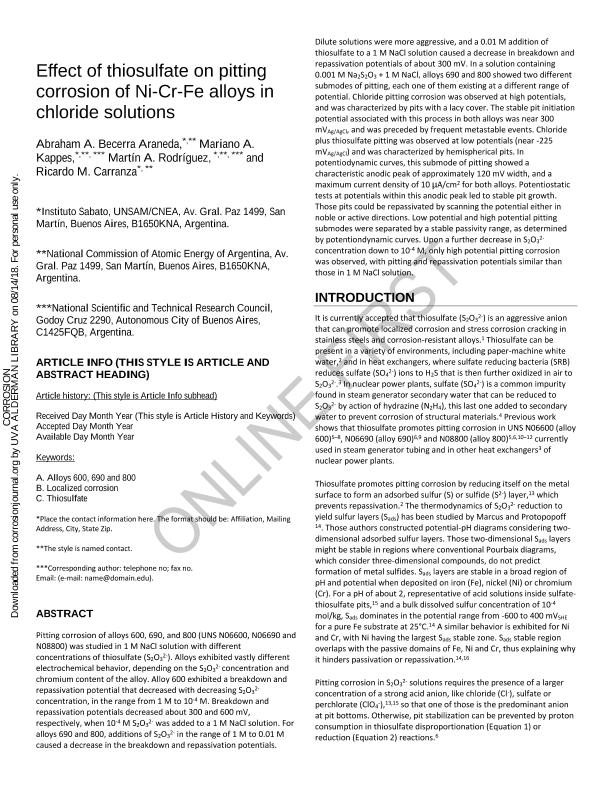Artículo
Effect of thiosulfate on pitting corrosion of Ni-Cr-Fe alloys in chloride solutions
Becerra Araneda, Abraham Alexis; Kappes, Mariano Alberto ; Rodríguez, Martín Alejandro
; Rodríguez, Martín Alejandro ; Carranza, Ricardo Mario
; Carranza, Ricardo Mario
 ; Rodríguez, Martín Alejandro
; Rodríguez, Martín Alejandro ; Carranza, Ricardo Mario
; Carranza, Ricardo Mario
Fecha de publicación:
11/2018
Editorial:
NACE International
Revista:
Corrosion
ISSN:
0010-9312
Idioma:
Inglés
Tipo de recurso:
Artículo publicado
Clasificación temática:
Resumen
Pitting corrosion of Alloys 600, 690, and 800 (UNS N06600, N06690, and N08800) was studied in 1 M NaCl solution with different concentrations of thiosulfate (S2O2 3 −). Alloys exhibited vastly different electrochemical behavior, depending on the S2O2 3 − concentration and chromium content of the alloy. Alloy 600 exhibited a breakdown and repassivation potential that decreased with decreasing S2O2 3 − concentration, in the range from 1 M to 10−4 M. Breakdown and repassivation potentials decreased about 300 mV and 600 mV, respectively, when 10−4 M S2O2 3 − was added to a 1 M NaCl solution. For Alloys 690 and 800, additions of S2O2 3 − in the range of 1 M to 0.01 M caused a decrease in the breakdown and repassivation potentials. Dilute solutions were more aggressive, and a 0.01 M addition of S2O2 3 − to a 1 M NaCl solution caused a decrease in breakdown and repassivation potentials of about 300 mV. In a solution containing 0.001 M Na2S2O3 + 1 M NaCl, Alloys 690 and 800 showed two different submodes of pitting, each one of them existing at a different range of potential. Chloride pitting corrosion was observed at high potentials and was characterized by pits with a lacy cover. The stable pit initiation potential associated with this process in both alloys was near 300 mVAg/AgCl and was preceded by frequent metastable events. Chloride plus S2O2 3 − pitting was observed at low potentials (near −225 mVAg/AgCl) and was characterized by hemispherical pits. In potentiodynamic curves, this submode of pitting showed a characteristic anodic peak of approximately 120 mV width and a maximum current density of 10 μA/cm2 for both alloys. Potentiostatic tests at potentials within this anodic peak led to stable pit growth. Those pits could be repassivated by scanning the potential either in noble or active directions. Low-potential and high-potential pitting submodes were separated by a stable passivity range, as determined by potentiodynamic curves. Upon a further decrease in S2O2 3 − concentration down to 10−4 M, only high-potential pitting corrosion was observed, with pitting and repassivation potentials similar than those in 1 M NaCl solution.
Palabras clave:
ALLOYS 600, 690 AND 800
,
LOCALIZED CORROSION
,
THIOSULFATE
Archivos asociados
Licencia
Identificadores
Colecciones
Articulos(SEDE CENTRAL)
Articulos de SEDE CENTRAL
Articulos de SEDE CENTRAL
Citación
Becerra Araneda, Abraham Alexis; Kappes, Mariano Alberto; Rodríguez, Martín Alejandro; Carranza, Ricardo Mario; Effect of thiosulfate on pitting corrosion of Ni-Cr-Fe alloys in chloride solutions; NACE International; Corrosion; 74; 11; 11-2018; 1214-1228
Compartir
Altmétricas



